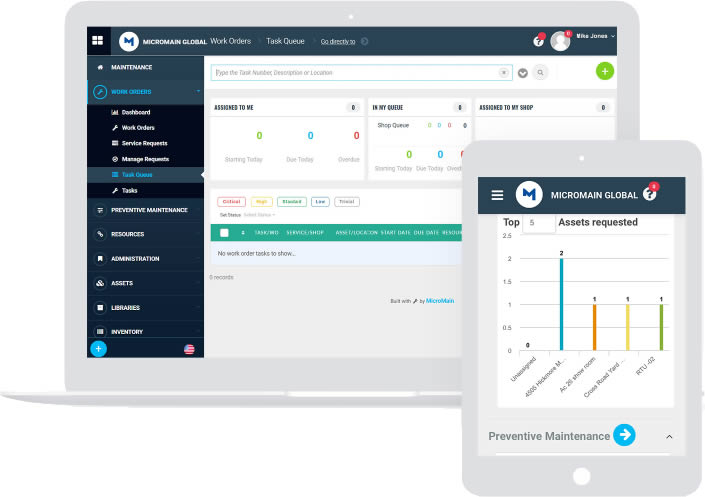Maintenance Management
What is Maintenance Management?
Maintenance management is a crucial system employed to strategically plan and organize maintenance resources, ensuring the continuous operational efficiency of vital assets. The primary objective is to monitor, control, and optimize the costs, time, and processes associated with maintenance activities, thereby maximizing equipment uptime and minimizing overall maintenance expenses.
While it’s possible to manually define maintenance needs, schedule activities at logical intervals, and manage parts inventory, the advent of maintenance management software takes these processes to the next level. This software not only streamlines but also automates and centralizes maintenance planning, tracking, and analysis tasks, introducing a new era of efficiency and resource optimization.
One key aspect enhanced by maintenance management software is preventive maintenance. This proactive approach to maintenance is facilitated by the systematic scheduling and automation capabilities embedded in the software, ensuring that preventive measures are consistently implemented.
Moreover, the integration of process automation within maintenance management software further revolutionizes how organizations handle maintenance tasks. Automation simplifies routine processes, accelerates response times, and minimizes the likelihood of human error. This not only increases the overall efficiency of maintenance operations but also contributes to substantial time and cost savings.
In conclusion, maintenance management software is a game-changer for organizations looking to optimize their maintenance processes. Embrace the power of maintenance management software to propel your organization towards a future of enhanced operational excellence and cost-effectiveness.
Benefits of Maintenance Management
The financial benefits of maintenance management that result from improved operational efficiency, equipment uptime, reduced repairs, and centralized operation are obvious, but these are just some of the myriad benefits of an effective maintenance program. The preventive maintenance’s system and features that improve the bottom line produce additional positive changes in unexpected ways.
Improved operational efficiency
Organized, well-planned maintenance introduces greater efficiency with less wasted time, effort, and parts. A proactive maintenance management approach uses data and trends to ensure resources are applied to the most value-added tasks. Computerized maintenance management makes it easier to track maintenance costs, shining a spotlight on less efficient, reactive maintenance practices.
Less equipment downtime
Inadequate or overdue maintenance can result in equipment downtime that impacts production and the bottom line. Maintenance management reduces downtime by ensuring the correct parts and personnel are available and maintenance backlogs are minimized. Strategic maintenance management also prevents unplanned downtime by continually targeting the true root causes of equipment failures.
Less repair costs
Repairs translate to higher unplanned maintenance labor and part costs. Well-maintained assets are less likely to break down, meaning repairs are less frequent. Preventive maintenance management, including predictive and condition-based data collection, reduces excessive wear and overuse of equipment. Time-consuming troubleshooting and repairs can be replaced by predictable operation and extended asset life.
Centralized operations
Maintenance management provides a centralized repository for work orders, historical asset data, inventory levels, and performance KPIs. This makes it easier to view the big picture and align resources with organizational needs. Instant access to this wealth of maintenance data across the organization also helps to standardize best practices.
Automated processes & reporting
The elimination of paperwork and manual processes is an additional benefit of computerized maintenance management. Planning and reporting tasks that once took hours or days can now be completed in minutes. This empowers maintenance personnel to focus on more valuable projects. At the same time, automated reporting functions reduce paper records by using tablets or smart phones to seamlessly collect and transfer data.
Improved safety
Workplace safety is an important benefit of equipment maintenance management that is sometimes underappreciated. By incorporating safety standards into maintenance practices and preventing equipment breakdowns and malfunctions, employee frustration and unsafe working conditions can be minimized. High morale and productivity are the byproducts of improved safety and predictable working conditions.
Improved customer satisfaction
Customer satisfaction can ultimately become another unexpected benefit of maintenance management. By keeping important assets running optimally, reducing downtime, and improving employee safety and morale, organizations can deliver higher quality products with reduced lead times and fewer unexpected delays.

How to Develop a Maintenance Management Plan
A strategic maintenance management plan is the first step on the path to an optimized maintenance organization. Even the best CMMS provides little value if automated data processing maintenance requirements, goals, and resources have not been agreed upon and a long-term maintenance strategy has not been developed.

Take inventory
The planning maintenance process should begin by taking stock of everything from equipment and spare part inventories to tools, consumables, infrastructure, and personnel. The equipment maintenance management plan should be tailored to the size and type of organization and be consistent with the resources available. This deep dive should also include a full assessment of technician skill sets and training, maintenance history, and existing procedures.

Define your maintenance strategy
Once the current state has been baselined and the strategic maintenance management team has been identified, the next phase of planning should focus on defining the overall maintenance strategy. Factors like equipment value and usage, historical failure trends, safety issues, and production schedules must be weighed carefully. Depending on the circumstances, some combination of reactive maintenance strategies like “run to failure”, along with condition-based or scheduled preventive maintenance for more important assets, may be adopted.

Gather data & refine processes
Maintenance management planning is an ongoing process that should not end when the maintenance software and system are deployed. Feedback from maintenance work orders, inventory usage patterns, and unplanned failures can guide future planning efforts and drive continuous improvement with process automation software. Maintenance management software can be used to analyze and integrate this feedback, ensuring the cost savings and best practices continue to evolve.
How Maintenance Management Software Can Help Maximize Efficiency
The benefits and objectives of Preventive maintenance management reach new heights with the implementation of CMMS software. Core functions like work order tracking, scheduling, and inventory control are not just streamlined but elevated to a level of unprecedented efficiency through automation.
Maintenance management software introduces a centralized portal, enabling real-time access to data, history, and reports. This convenience extends to supporting activities such as audit planning and response, employee training, and KPI reporting, creating a comprehensive solution for effective maintenance practices.
In today’s mobile environment, CMMS software finds innovative applications. As the Internet of Things (IoT) and Industry 4.0 become mainstream, maintenance management software plays a pivotal role in monitoring data from advanced sensors, facilitating condition-based maintenance. Wireless communication of service requests and results further optimizes efficiency, saving valuable transportation and reporting time.
The analytical prowess of maintenance management software transforms data into actionable insights, driving continuous improvement. Unlike traditional preventive maintenance intervals, the best software automatically optimizes maintenance cycles or generates work orders based on time, usage, condition, and other factors, ensuring a proactive and tailored approach to maintenance.
How to Choose the Best Maintenance Management Software

Any organization, large or small, can benefit from maintenance management. The power and convenience of CMMS software can enhance this transition. Choosing the best CMMS software for your organization is a pivotal decision. Here are some factors to consider:
Assess your situation
Creating a detailed baseline of maintenance requirements and resources is a great way to kickstart the CMMS selection process. Also consider your software process automation budget, how often equipment needs to be maintained, how extensive and complex inventories are, and how many technicians and other personnel will use the system.
Define goals & expectations
The next step in selecting the best maintenance management for your organization is to define the goals and expectations for the software deployment, and separate needs from wants
Make a list of required features
More advanced features could come with a higher price tag or require more IT support. On the other hand, a basic software package might be outgrown too quickly as the organization evolves and considers predictive maintenance, barcoding, wireless work order tracking, and other time-saving practices.
Consider integration with your current systems
Once your maintenance management team has agreed on a feature set, the next step is to define how you expect the maintenance system to perform. This includes the types of preventive maintenance you want to include, the reporting functions you need, and how the MRO functions will be integrated with other ERP and accounting systems.
Sign up for demos & free trials
Once you’ve narrowed your search, requesting a demo or free trial from your top vendors is a good way to build confidence in the final choice.MicroMain offers powerful, easy-to-use, maintenance management software with a proven track record of increased productivity and reduced overall maintenance costs. Customers in industries ranging from manufacturing and agriculture to healthcare and education benefit from our cost-effective, feature-rich platform. By efficiently tracking labor, parts, and equipment, our CMMS software shifts the focus from the task at hand to the unlimited improvement opportunities ahead.
MicroMain offers powerful, easy-to-use, maintenance management software with a proven track record of increased productivity and reduced overall maintenance costs. Customers in industries ranging from manufacturing and agriculture to healthcare and education benefit from our cost-effective, feature-rich platform. By efficiently tracking labor, parts, and equipment, our CMMS software shifts the focus from the task at hand to the unlimited improvement opportunities ahead.
Book a Demo
We're friendly and helpfulLet one of our software experts walk you through the powerful features our CMMS offers.

Start a Free Trial
No Credit Card RequiredExplore all of the powerful features of our CMMS / EAM software and see how easy it is to use.

Watch Demo Videos
See Our Software In ActionWant to see how our software works? Watch some of our helpful demo videos!
Why maintenance management is important
Industrial equipment, facilities, and automation continue to become more complex, making maintenance management a necessity rather than a luxury.
It helps you achieve your organizational goals.
Without the centralization, organization, and continuous improvement enabled through proactive maintenance management, resources can easily become misaligned with organizational needs, while equipment breakdowns, troubleshooting, and excessive overtime can lead to a competitive disadvantage.
It impacts your bottom line.
Strategic preventive maintenance management directly impacts an organization’s bottom line by increasing equipment lifespan and minimizing planned and unplanned downtime. This creates cost savings through reduced labor and materials.The bottom line: vastly improved production efficiency resulting from more reliable and consistent maintenance operations.
It enables you to extract insights from your data.
The internal and external reporting capabilities of an effective maintenance management system are also extremely important. Federal, state, and local regulations make data organization and retrieval essential for complaint response and regulatory compliance. Reporting functions allow internal goals, metrics, and key performance indicators (KPIs) to be tracked and communicated easily. Maintenance software can help an organization generate meaningful reports quickly to support both external compliance and internal maintenance objectives.
Different types of maintenance management
Maintenance management is a broad term that encompasses multiple functions involved in the planning, execution, and improvement of maintenance operations. A centralized maintenance management strategy introduces greater efficiency and transparency between these areas.
- Work Order Management.
Work order management is used to assign and track maintenance tasks, along with the tools, parts, and labor used to complete them. CMMS software compliments work order management by setting due dates and automating tracking and alerts. - Facility Management.
Facility management is often considered an independent function, but many facility-related services including HVAC, electrical, waste management, and environmental health and safety (EHS) are closely interrelated with equipment maintenance management. The same logic used to create preventive and predictive maintenance plans for production machinery can also be applied to building, service, and utility maintenance. - Parts and Inventory Management.
Parts and inventory management often overlaps with other procurement functions with a unique slant towards the spare parts, consumables, PPE, and other items that keep maintenance operations running smoothly. Preventive maintenance management can be used to plan purchase orders based on maintenance schedules, organize and track inventory locations, and set alerts when quantities on hand drop below predetermined levels.
The objectives of maintenance management
In any industry, maintenance management systems share similar objectives that can be used to measure the value and effectiveness of the program.
Improve scheduling and prioritization of work orders: By analyzing the importance of assets along with maintenance data and trends, you can apply resources to the most value-added tasks. This is best accomplished by taking a proactive rather than reactive approach to maintenance.
Extend useful life of equipment and infrastructure: Preventive maintenance, which also includes predictive and condition-based approaches, combines real time asset inspection and sensor data with historical performance information to optimize maintenance processes and intervals. Excessive wear or overuse of equipment and parts is avoided along with breakdowns and line stoppages.
Manage budgets: Computerized maintenance management not only leads to reduced expenses through efficiency gains, prolonged asset life with asset maintenance software, and predictable quality, it also provides an ideal cost control platform for comparing maintenance expenditures to budgets. Maintenance management makes it easier to track and analyze how maintenance funds are allocated, shining a spotlight on the less efficient, reactive maintenance practices that lead to higher material and labor costs.
